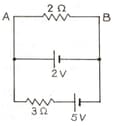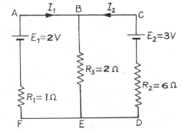Determine current in resistance and potential difference between and in the adjoining circuit diagram.



Important Questions on DC Circuits and Measurements
In the circuit shown in figure, and . Using Kirchhoff's laws, find currents flowing through resistors and (internal resistance of each of the batteries is negligible)

In the given circuit and are two cells of emfs and respectively, having negligible internal resistances. Applying Kirchhoff’s laws of electrical networks, find the values of and .

Two cells and of emf's and respectively, each having an internal resistance of send current in an external resistance of . Find the magnitudes and the directions of currents and flowing through the cells and .

Calculate the currents and in the given The cells have negligible internal resistances.

